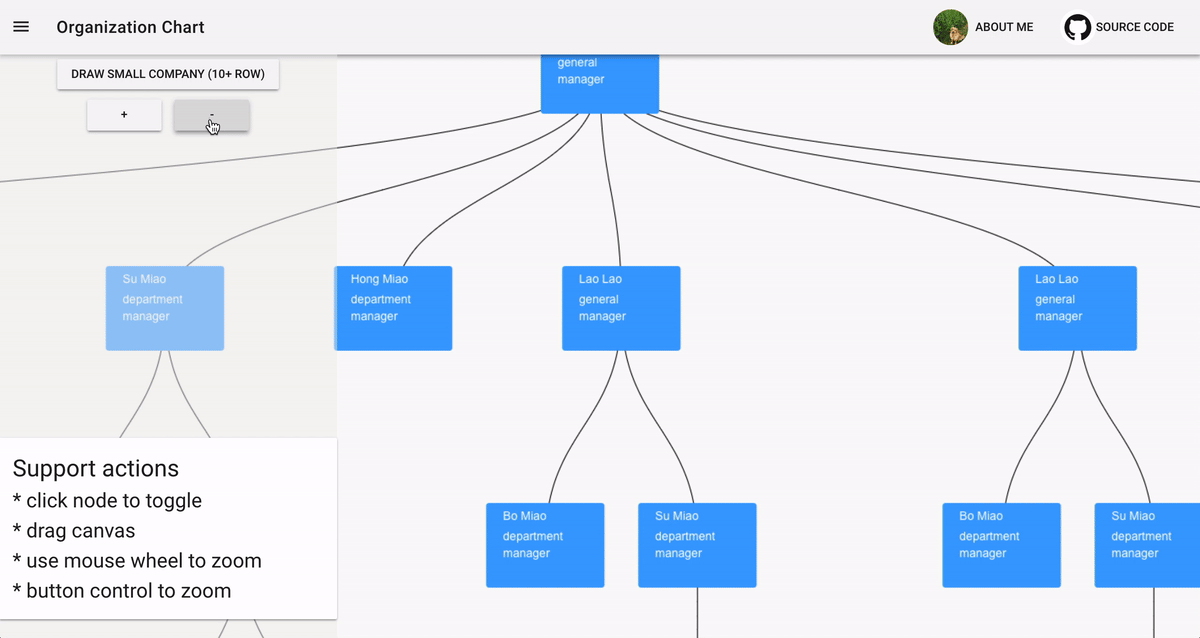https://ssthouse.github.io/vue-tree-chart/#/svgTree
- use D3.js with Canvas to draw organizationChart more efficiently.
- Use
unique-colormanner to identify mouse click event in Canvas (you can refer to https://medium.com/@lverspohl/how-to-turn-d3-and-canvas-into-good-friends-b7a240a32915 to see detail)
- use D3 to calculate node & link positon
- use Vue to handle dom element entring and leaving
- use Vue slot to let user easily use with their own data
npm install @ssthouse/vue-tree-chartimport VueTree from '@ssthouse/vue-tree-chart'
import Vue from 'vue'
Vue.component('vue-tree', VueTree)3.1 basic usage
See Code
<template>
<div class="container">
<vue-tree
style="width: 800px; height: 600px; border: 1px solid gray;"
:dataset="sampleData"
:config="treeConfig"
>
</vue-tree>
</div>
</template>
<script>
export default {
name: 'treemap',
data() {
return {
sampleData: {
value: '1',
children: [
{ value: '2', children: [{ value: '4' }, { value: '5' }] },
{ value: '3' }
]
},
treeConfig: { nodeWidth: 120, nodeHeight: 80, levelHeight: 200 }
}
}
}
</script>
<style scoped lang="less">
.container {
display: flex;
flex-direction: column;
align-items: center;
}
</style>3.2 show collapsed node in different style
See Code
<template>
<div class="container">
<vue-tree
style="width: 800px; height: 600px; border: 1px solid gray;"
:dataset="sampleData"
:config="treeConfig"
>
<template v-slot:node="{ node, collapsed }">
<span
class="tree-node"
:style="{ border: collapsed ? '2px solid grey' : '' }"
>{{ node.value }}</span
>
</template>
</vue-tree>
</div>
</template>
<script>
export default {
name: 'treemap',
data() {
return {
sampleData: {
value: '1',
children: [
{ value: '2', children: [{ value: '4' }, { value: '5' }] },
{ value: '3' }
]
},
treeConfig: { nodeWidth: 120, nodeHeight: 80, levelHeight: 200 }
}
}
}
</script>
<style scoped lang="less">
.container {
display: flex;
flex-direction: column;
align-items: center;
}
.tree-node {
display: inline-block;
width: 28px;
height: 28px;
border-radius: 50%;
background-color: antiquewhite;
text-align: center;
line-height: 28px;
}
</style>3.3 render rich media data
See Code
<template>
<div class="container">
<vue-tree
style="width: 1000px; height: 600px; border: 1px solid gray;"
:dataset="richMediaData"
:config="treeConfig"
>
<template v-slot:node="{ node, collapsed }">
<div
class="rich-media-node"
:style="{ border: collapsed ? '2px solid grey' : '' }"
>
<img
:src="node.avatar"
style="width: 48px; height: 48px; border-raduis: 4px;"
/>
<span style="padding: 4px 0; font-weight: bold;"
>能力值{{ node.value }}</span
>
</div>
</template>
</vue-tree>
</div>
</template>
<script>
export default {
name: 'treemap',
data() {
return {
richMediaData: {
name: 'James',
value: 800,
avatar:
'https://gravatar.com/avatar/db51fdaf64d942180b5200ca37d155a4?s=400&d=robohash&r=x',
children: [
{
name: 'Bob',
value: 400,
avatar:
'https://gravatar.com/avatar/16b3b886b837257757c5961513396a06?s=400&d=robohash&r=x',
children: [
{
name: 'C1',
value: 100,
avatar:
'https://gravatar.com/avatar/4ee8775f23f12755db978cccdc1356d9?s=400&d=robohash&r=x'
},
{
name: 'C2',
value: 300,
avatar:
'https://gravatar.com/avatar/d3efa8fa639bdada96a7d0b4372e0a96?s=400&d=robohash&r=x'
},
{
name: 'C3',
value: 200,
avatar:
'https://gravatar.com/avatar/4905bc3e5dc51a61e3b490ccf1891107?s=400&d=robohash&r=x'
}
]
},
{
name: 'Smith',
value: 200,
avatar:
'https://gravatar.com/avatar/d05d081dbbb513180025300b715d5656?s=400&d=robohash&r=x',
children: [
{
name: 'S1',
value: 230,
avatar:
'https://gravatar.com/avatar/60c1e69e690d943c5dc06568148debc4?s=400&d=robohash&r=x'
}
]
},
{
name: 'Jackson',
value: 300,
avatar:
'https://gravatar.com/avatar/581f7a711c815d9671c35ebd815ec1e4?s=400&d=robohash&r=x'
}
]
},
treeConfig: { nodeWidth: 120, nodeHeight: 80, levelHeight: 200 }
}
}
}
</script>
<style scoped lang="less">
.container {
display: flex;
flex-direction: column;
align-items: center;
}
.rich-media-node {
width: 80px;
padding: 8px;
display: flex;
flex-direction: column;
align-items: flex-start;
justify-content: center;
color: white;
background-color: #f7c616;
border-radius: 4px;
}
</style>3.4 render tree with multiple parents
See Code
<template>
<div class='container'>
<vue-tree
style="width: 800px; height: 600px; border: 1px solid gray;"
:dataset="vehicules"
:config="treeConfig"
linkStyle="straight"
>
<template v-slot:node="{ node, collapsed }">
<div
class="rich-media-node"
:style="{ border: collapsed ? '2px solid grey' : '' }"
>
<span style="padding: 4px 0; font-weight: bold;"
>能力值{{ node.name }}</span
>
</div>
</template>
</vue-tree>
</div>
</template>
<script>
export default {
name: 'treemap',
data() {
return {
vehicules: {
name: 'Wheels',
children: [
{
name: 'Wings',
children: [
{
name: 'Plane'
}
]
},
{
name: 'Piston',
customID: 3
},
{
name: 'Carburetor',
children: [
{
name: 'Truck',
customID: 2
},
{
name: 'Car',
customID: 2
}
]
},
{
name: 'Valve',
customID: 4
},
{
name: 'Crankshaft',
customID: 1
}
],
links: [
{ parent: 1, child: 2 },
{ parent: 3, child: 2 },
{ parent: 4, child: 2 }
],
identifier: 'customID'
},
treeConfig: { nodeWidth: 120, nodeHeight: 80, levelHeight: 200 }
}
}
}
</script>
<style scoped lang="less">
.container {
display: flex;
flex-direction: column;
align-items: center;
}
.rich-media-node {
width: 80px;
padding: 8px;
display: flex;
flex-direction: column;
align-items: flex-start;
justify-content: center;
color: white;
background-color: #f7c616;
border-radius: 4px;
}
</style>4.1 props
| type | default | description | |
|---|---|---|---|
| dataset | Object | null | nested tree data |
| config | Object | { nodeWidth: 100, nodeHeight: 100, levelHeight: 200 } |
nodeWidth and nodeHeight config the tree node size. levelHeight is tree row height |
| linkStyle | String | 'curve' | control link style, options: 'curve' or 'straight' |
| direction | string | 'vertical' | control tree chart direction, options: 'vertical' or 'horizontal' |
| collapse-enabled | Boolean | true | Control whether when clicking on a node it collapses its children |
4.2 slot
this component only support default slot.
a sample usage like this:
<template v-slot:node="{ node, collapsed }">
<span
class="tree-node"
:style="{ border: collapsed ? '2px solid grey' : '' }"
>{{ node.value }}</span
>
</template>there are two slot params provided to render slot content:
| slot param | type | description |
|---|---|---|
| node | Object | current node data to be rendered |
| collapsed | Boolean | current node collapse status |
4.3 API > zoom
use vue ref to call zoom api.
support methods:
zoom in: this.$refs.tree.zoomIn()
zoom out: this.$refs.tree.zoomOut()
restore initial scale: this.$refs.tree.restoreScale()
the canvas version is not published with npm module.
if you want to use this project's canvas version, please download the source code and edit with the following steps:
- replace the data in
/src/base/data-generator.jswith your own nested data. - add your data drawing logic in
/src/components/org-chart.js #drawShowCanvas
# install dependencies
npm install
# serve with hot reload at localhost
npm run dev
# build for production with minification (build to ./docs folder, which can be auto servered by github page 🤓)
npm run build



